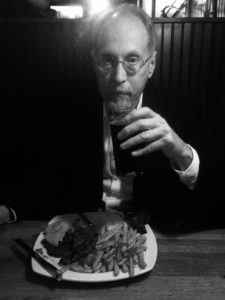Noir and Literary Fiction: Plot Meets Characterization
 Since 2004, Akashic Books, an independent publisher in Brooklyn, has published a series of noir stories set in specific locales around the world. Although I’ve never thought of myself as a noir writer, I’ve been invited to contribute to two of the books in this series—Memphis, Noir, and the recently released, Columbus, Noir. In fact, I’ll be talking a bit about noir and my story in this anthology at 7pm this Wednesday, April 22, via the Columbus, Noir Live Reading Events on Facebook.
Since 2004, Akashic Books, an independent publisher in Brooklyn, has published a series of noir stories set in specific locales around the world. Although I’ve never thought of myself as a noir writer, I’ve been invited to contribute to two of the books in this series—Memphis, Noir, and the recently released, Columbus, Noir. In fact, I’ll be talking a bit about noir and my story in this anthology at 7pm this Wednesday, April 22, via the Columbus, Noir Live Reading Events on Facebook.
I suppose, if we start with the basic idea that the worlds of such stories are dark, it makes sense that my work has a certain appeal to fans of noir. Most of my novels have been based on true crime stories, but what draws me to them isn’t the subject matter itself but more the characters who find themselves, usually from their own doing, caught in these dark worlds, characters whom Otto Penzler, series editor of the annual Best American Mystery Stories, as well as the anthology, Best American Noir of the Century, would call “the lost characters. . .who are caught in the inescapable prisons of their own construction.” Penzler goes onto say, “The people in noir fiction are dark and doomed—they are losers, they are pessimistic, they are hopeless.” In the introduction to Columbus, Noir, editor Andrew Welsh-Huggins, highlights one of the hallmarks of noir: “protagonists striving for things out of their reach.” This striving, because of what one lacks or what one fears or what one desires, makes perfect sense to any piece of fiction, noir or otherwise, and it’s here—this place where characterization meets plot—where literary fiction can co-exist with genre fiction.
My story in Columbus, Noir, “The Luckiest Man Alive,” relies, as so much of my fiction does, on what my protagonist carries with him into what I like to call the dramatic present of the narrative. The story opens with my protagonist imagining he overhears a young woman confessing to a murder. He tries to convince himself he’s misheard, but he can’t forget what he swears he heard the young woman say: “I didn’t mean to kill her.” The next morning, he reads a story in the Columbus Dispatch about a girl’s body being pulled from the waters of an abandoned rock quarry near where he lives and that’s enough to persuade him that indeed he may have relevant information about a suspect. Now he has choices to make, and like in any piece of fiction I write, I want his decisions to be the wrong ones so the plot can have its further complications along with a further complexity of character. In my aesthetic, the plot points are always there, not just to make an interesting narrative, but to also carry us deeper into the multiple layers that make up an interesting character. That’s where the backstory comes into play. What my character carries forward from his past has everything to do with the choices he makes in the present and those choices reveal more of the person than would otherwise be known.
The protagonist of “The Luckiest Man Alive” is living alone on the other side of a marriage that came apart after the death of his daughter, a death he accidentally caused. When he shows the news story about the body pulled from the quarry to a work friend and tells him he may know who’s responsible, the friend, who knows the story about the dead daughter, immediately understands why the protagonist insists he heard the killer’s confession:
He knows now that I want the girl’s death to be suspicious because I want to hold everyone to account. I’ll be even more direct—I want as much proof as I can get that we’re responsible for the people we love and then lose, that effect follows cause, that there’s no God to save us. There’s only our own stupidity and the ruin we make. I don’t want to be alone.
It’s at this point—when the past overlays the present—that the protagonist has to acknowledge what he’s tried to keep submerged: His guilt over the death of his daughter has led to a desire to hold everyone responsible for the ruin they create so he won’t have to be alone with his misery. Bit by bit, via his own choices, the protagonist becomes more known to himself, and if I’m doing this right, maybe the readers have more insight into why people do what they do. To my way of thinking, this is why plot exists, to put pressure on characters until we all become alive to one another. That’s what interests me in fiction—this union of character and plot—and if I find it in noir, so be it. “Have you ever lifted up a rock and seen slugs and millipedes and other ugly creatures come out?” Otto Penzler asked an interviewer from The New Yorker. “We like to watch them.” That’s what I do as a fiction writer. I watch characters who are in some sort of trouble—usually of their own making—to see how they might surprise me and in the process show me something I didn’t know about what it is to be human.
I really needed to read this today, Lee, so thank you.
Denise, I hope you and yours are doing well!